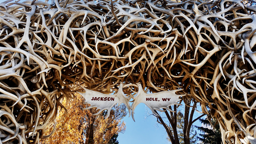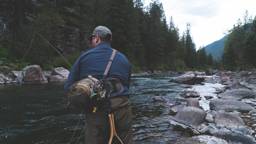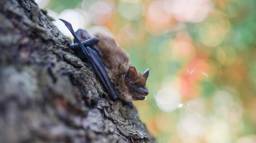There I was, enjoying an afternoon saunter on a mellow dirt path in one of Washington State’s deep, dark ancient forests. I’d just rounded a bend when I saw it: a black furry back – a black bear! – high-tailing it down the trail away from me as fast as he could.
Thankfully, the bear wanted nothing to do with me and was so scared he tried to scramble up a tree. The tree he picked, however, was too big around at the base, and he couldn’t get a grip. He kind of bounced off and slid down to the ground, just like in a cartoon. Then he turned and began walking slowly toward me, menacingly swinging his head from side to side. Yikes!
If you pursue your passion for the outdoors, it’s likely that you’re going to have a wildlife encounter, whether it’s with a bear, mountain lion, moose, rattlesnake, or a creature at the opposite end of the size spectrum – bees. In most instances, wildlife will make like that black bear – they’ll scram when they know you’re near. But what if, as also happened with that bear, you find yourself face to face with curious and/or threatening wildlife? Here’s what to do:
Black bear
Luckily, about a week before my bear encounter, I’d spoken with a ranger about just such an encounter. Never run – a human can’t outrun a bear – but stay still and speak quietly to it in a low voice. Don’t make eye contact with the bear, and give it plenty of room to get away.
Thankfully, the bear wanted nothing to do with me and was so scared he tried to scramble up a tree. The tree he picked, however, was too big around at the base, and he couldn’t get a grip. He kind of bounced off and slid down to the ground, just like in a cartoon. Then he turned and began walking slowly toward me, menacingly swinging his head from side to side. Yikes!
If you pursue your passion for the outdoors, it’s likely that you’re going to have a wildlife encounter, whether it’s with a bear, mountain lion, moose, rattlesnake, or a creature at the opposite end of the size spectrum – bees. In most instances, wildlife will make like that black bear – they’ll scram when they know you’re near. But what if, as also happened with that bear, you find yourself face to face with curious and/or threatening wildlife? Here’s what to do:
Black bear
Luckily, about a week before my bear encounter, I’d spoken with a ranger about just such an encounter. Never run – a human can’t outrun a bear – but stay still and speak quietly to it in a low voice. Don’t make eye contact with the bear, and give it plenty of room to get away.
This last bit of advice seemed to do the trick, for as the bear approached close enough that I was getting truly worried, I stepped off the trail while still facing him. Immediately, he bolted off into the woods away from me, and a bigger sigh of relief was never breathed by a human being.
Other tips: Never get between a cub and its mother. (This is good advice for all wildlife, really.) If you can’t get away, clap or yell in an effort to scare it away. If the bear attacks, fight back using anything at your disposal. If you’re carrying bear spray, use it. If the attack continues, curl up in a ball or lie on your stomach and play dead.
Grizzly bear
Most of the above applies to grizzly bear encounters also. But if a grizzly attacks, play dead immediately. Don’t fight back. Lie face down, and cover the back of your neck to protect it. Be silent, and even after the bear has moved on, remain still and quiet until you are positive the bear has left the area.
Other tips: Never get between a cub and its mother. (This is good advice for all wildlife, really.) If you can’t get away, clap or yell in an effort to scare it away. If the bear attacks, fight back using anything at your disposal. If you’re carrying bear spray, use it. If the attack continues, curl up in a ball or lie on your stomach and play dead.
Grizzly bear
Most of the above applies to grizzly bear encounters also. But if a grizzly attacks, play dead immediately. Don’t fight back. Lie face down, and cover the back of your neck to protect it. Be silent, and even after the bear has moved on, remain still and quiet until you are positive the bear has left the area.
Mountain lion
As with bear encounters, don’t run if you come across a mountain lion. However, it is advisable to maintain direct eye contact with the big cat. Make yourself appear big by raising your arms above your head, opening your jacket, and waving a hiking stick, trekking pole or whatever you’ve got access to, above your head. If the cougar approaches, yell and throw rocks, sticks – anything you can get your hands on. In the event of an attack, fight back as aggressively as possible, using anything at your disposal as a weapon.
As with bear encounters, don’t run if you come across a mountain lion. However, it is advisable to maintain direct eye contact with the big cat. Make yourself appear big by raising your arms above your head, opening your jacket, and waving a hiking stick, trekking pole or whatever you’ve got access to, above your head. If the cougar approaches, yell and throw rocks, sticks – anything you can get your hands on. In the event of an attack, fight back as aggressively as possible, using anything at your disposal as a weapon.
Moose
If you encounter a moose, move slowly around it and give it plenty of space. In the unlikely event that it charges you, run; unlike bears and mountain lions, moose won’t chase you very far, and your chances of outrunning a moose are good. Run behind something solid and large, such as a tree or boulder.
If a moose attacks – they can kick lethally with both their fore and hind legs – and you’re knocked to the ground, play dead and protect your head. As with a grizzly attack, keep still and don’t move until you know the moose is gone.
If you encounter a moose, move slowly around it and give it plenty of space. In the unlikely event that it charges you, run; unlike bears and mountain lions, moose won’t chase you very far, and your chances of outrunning a moose are good. Run behind something solid and large, such as a tree or boulder.
If a moose attacks – they can kick lethally with both their fore and hind legs – and you’re knocked to the ground, play dead and protect your head. As with a grizzly attack, keep still and don’t move until you know the moose is gone.
Rattlesnake
Most of the time, if you come across a rattlesnake, it will slither away. But if it doesn’t, give it plenty of space – about 10 feet – and walk around it. Although their bites can be dry, it’s not the type of thing that you should take a chance with. If you’re bitten, seek medical treatment as soon as possible.
Bees
Relative to the above critters, bees are tiny, and sometimes you don’t even know that they’re in the vicinity until you’ve been stung. Thus, precaution is key. Bees seek flowers, so try not to look or smell like one when you’re hiking. Wear muted colors and avoid scented lotions, perfumes, hair gel and the like. Shiny jewelry can attract bees as well. Keep your food and drinks sealed or covered, and wear long pants and long sleeves. If you encounter an active hive, move slowly around it, avoiding sudden movements.
In the event of a sting, remove the stinger, using your fingernail or by sliding gauze across it (don’t use tweezers). Apply ice to reduce swelling and discomfort. If you or someone in your hiking party is allergic to bee stings, always carry an EpiPen, and know how to use it. Seek medical attention as quickly as possible.
Mike McQuaide is a freelance writer and guidebook author who lives in Bellingham, Wash. He’s had his fill of close-call wildlife encounters and now prefers the kind that are best dealt with by changing the channel.
Most of the time, if you come across a rattlesnake, it will slither away. But if it doesn’t, give it plenty of space – about 10 feet – and walk around it. Although their bites can be dry, it’s not the type of thing that you should take a chance with. If you’re bitten, seek medical treatment as soon as possible.
Bees
Relative to the above critters, bees are tiny, and sometimes you don’t even know that they’re in the vicinity until you’ve been stung. Thus, precaution is key. Bees seek flowers, so try not to look or smell like one when you’re hiking. Wear muted colors and avoid scented lotions, perfumes, hair gel and the like. Shiny jewelry can attract bees as well. Keep your food and drinks sealed or covered, and wear long pants and long sleeves. If you encounter an active hive, move slowly around it, avoiding sudden movements.
In the event of a sting, remove the stinger, using your fingernail or by sliding gauze across it (don’t use tweezers). Apply ice to reduce swelling and discomfort. If you or someone in your hiking party is allergic to bee stings, always carry an EpiPen, and know how to use it. Seek medical attention as quickly as possible.
Mike McQuaide is a freelance writer and guidebook author who lives in Bellingham, Wash. He’s had his fill of close-call wildlife encounters and now prefers the kind that are best dealt with by changing the channel.

 Photos.com
Photos.com 
 Photos.com
Photos.com  Photos.com
Photos.com  Photos.com
Photos.com  Photos.com
Photos.com  Photos.com
Photos.com 









